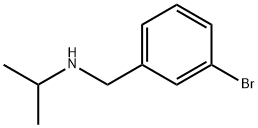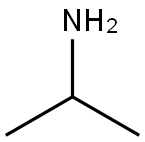
N-(3-BROMOBENZYL)-N-ISOPROPYLAMINE synthesis
- Product Name:N-(3-BROMOBENZYL)-N-ISOPROPYLAMINE
- CAS Number:110079-41-9
- Molecular formula:C10H14BrN
- Molecular Weight:228.13

75-31-0
444 suppliers
$14.00/25mL

932-77-4
143 suppliers
$9.00/1g

110079-41-9
20 suppliers
$100.83/1g
Yield:110079-41-9 1.35 g
Reaction Conditions:
with potassium carbonate in acetonitrile; for 6 h;Reflux;
Steps:
1.b
b) 0.8ml 3-bromobenzyl chloride (6mmol) is dissolved in 30ml acetonitrile, 1ml isopropylamine (12mmol), 4.15g anhydrous potassium carbonate (30mmol) are added, and the reaction is refluxed for 6h. TLC detection shows that the reaction is almost complete. Concentrate under reduced pressure , Ethyl acetate was re-dissolved, and after washing with water, the organic layer was dried over anhydrous sodium sulfate, and concentrated under reduced pressure to obtain 1.35 g of oil.Dissolve 600mg of the obtained oily substance (2.6mmol) in 10ml toluene and 10ml ethanol, add 480mg 3-pyridineboronic acid (3.9mmol), 20mg tetrakis(triphenylphosphine) palladium, 10ml 2mol/L sodium carbonate solution, nitrogen protection After reacting at 100°C for 6 hours, TLC detection showed that the reaction was basically complete, filtered through Celite, concentrated the filtrate under reduced pressure, dissolved in ethyl acetate, washed with distilled water, dried organic layer with anhydrous sodium sulfate, concentrated under reduced pressure, 505 mg of oily product was separated out with a yield of 86%.
References:
CN112010804,2020,A Location in patent:Paragraph 0068; 0080; 0083